Everyone else has had to write about one specific day. One miniscule dot of time within our three-week trip. For a single day even three thousand words could not possibly describe the sights I have seen, the emotions I have felt and the culture I have absorbed. It is impossible to give a summary of such an experience, but I can give a brief insight into the life and memories of a student abroad. Of course, because I was a student abroad it is only right that I talk about the student aspect of the trip. I never knew that classes could be both three hours long and entertaining. These are two concepts that should not pair well but somehow, they did. The teachers clearly cared about us and our learning. They tried to make the classes fun with class and group activities which only furthered our Spanish speaking. There were also so many things our teachers had no concept of from America and vice versa. Each class was an exchange of culture from students to teacher and teacher to students. The highlight of these class though, was probably the bike ride. Each morning we woke up and ate our surprisingly decent Olarain breakfast and biked to class at nine in the morning. The first day we biked to class I was unable to admire the view since I was running on three hours of sleep. But on the second day, I was able to absorb the breathtaking sights of San Sebastian. The gorgeous turquoise water welcoming the suns rays. The statue of Jesus on Mt. Urgull staring down at the vibrant city as if he is their protector. The city streets which were lined with unique architectural styles and the infamous Spanish style roofs which are more colorful and stylish than the dull gray ones we have at home. All of it was completely new to me and each bike ride I could not help but stare and think that I was somewhere I had never been before. And the trips I went on with other classmates only further enveloped myself within the Basque country of Spain. One of my favorite memories has to be hiking up and around the mountains to Pasaia. It was a two-hour hike in which my legs burned with each step, and I almost fell on the steep steps a couple of times. In the moment, I felt like death but the views from the mountain helped to alleviate this pain almost entirely. The path was along the outskirts of the mountain and there was little bramble and trees in the way, so the view was perfect. The ocean stretched on for hundreds upon hundreds of miles, encompassing the landscape as I realized that home was across that great blue expanse. The clouds blanketed the light blue sky as far as the eye could see as well, deep into the horizon. The city of Pasaia was remarkable as well. It lay tucked into the mountains, cradled by the Earth, separated by a river in which a ferry was needed to get to the other side. There we visited a boat museum and factory which detailed the history of the Basques as fishermen and whalers. There was also a replica of a Basque ship being built there, years of hard work all to recreate the culture of the Basque people. I say that as if the Basque culture is dying out, but in no way is that the case. During the grand festival which started on August 13th the culture of the Basque had been displayed every day until yesterday when I left. At the beginning of the “semana grande” as the Spanish call it, a cannon was used to commence the party and people dressed in traditional Basque/Spanish outfits to dance and sing. I can’t say I understood any of the concerts that were displayed but they were still impressive. As others sang in Basque in the center of Old Town kids danced with a joyous vitality and I wondered how they never ran out of energy. But just looking around everyone seemed the same way. Simply full of joy unlike I had ever seen before. That is all I needed to see to know that this was something special to them. Their culture is something they cherish, and they love they country they live in. I can see why after spending three weeks there. This trip was only three weeks but, it is something I will look back upon with joy for the rest of my life.
Monthly Archives: August 2022
Agur San Sebastián!
Walking into the room, it finally hit: three weeks have come to an end. I look around at all the faces, faces that I had never seen before three weeks ago. Now they were faces that were going to become familiar when walking around campus. Three weeks in an unfamiliar country with unfamiliar people was an incredible, once in a lifetime experience and I am so grateful I was able to participate in this journey.
In restaurant Aitana, as we sat down to eat we were very impressed by how nice the setting and the atmosphere was for the dinner. We had a beautiful private room in the back with greenery falling down from the walls. Props to Professor Z for picking such a nice place for us! While waiting for food, it was such a wholesome moment to watch. Everyone was reminiscing in their memories they made during the three weeks, laughing and getting along. The good ones, the bad ones, the scary ones, the funny ones. We all had one thing in common and it is the little stories we are going to bring back with us from San Sebastián.
For my readers or potential participants of study aboard, I figured I would compile some information from that would be helpful. I first started off by asking what is one piece of advice you would give to people traveling here. Some were packing tips such as packing less, packing sunscreen as it can get quite sunny and a raincoat as it can also get very rainy. One said another thing to pack is a journal to be able to write down everything you’ve experienced and keep track of day to day activities. One said keeping an open mind. San Sebestian has a very unique culture and it is important to be respectful and accepting of how differently they do things than one is used to. You should always be down to try new things. One said to keep track of things you see so you can come back to do them later. Take pictures of stores or activities that you see on your way to other places so later you will be able to come back to see them. Another very important piece of advice is do not take time for granted. Three weeks may seem long in theory but towards the end you realize there is still so much to do and see. Lastly, one said it is ok to be alone at times or to explore the city by yourself at least once. That is when you experience the most things as you only have yourself to rely on and are able to find out more about your potential.
As I mentioned how unique the culture is here I next wanted to find out what the biggest culture shock was to them. The one thing that stands out in San Sebastián are the pintxo bars and how many of them there are. Just walking down the road you can find so many bars to choose from. In fact there are very few restaurants. Every restaurant is a bar but not every bar is a restaurant meaning in not every bar will you find a full meal. Next, it seems like everyone here has a dog and the dogs are extremely well trained and loyal. You will see dogs walking next to their owners off the leash amongst a crowd of people and not bark or run away. Another big thing was how women could be topless at beaches and how everyone was respectful about it. You would even see young kids completely undressed at the beach. Something like this back at home would not go so smoothly but here it is completely normalized. The city is so well made that it is possible to walk or bike anywhere. Walking takes a bit more time but the city is very bike friendly which makes it a reliable source of transportation. Another shocking thing was if you ever get thirsty you can literally drink the water from anywhere this even includes the bathroom sink, the shower, etc. There are plenty of water fountains placed all around the city for you to refill your water bottle. Lastly we all agreed that although San Sebastián is a city it does not move fast. Compared to other cities, San Sebastián is very relaxed. The people here take their jobs seriously but are so carefree and do not hold the burden of stress. We saw this being promoted by almost everything being closed on Sundays and the idea of siestas where everything closes from 2 to 5 for people to have lunch and to take a nap. Overall everyone seemed to really enjoy this type of relaxed feel while being in the city.
To finish off the dinner we reminisced more into our favorite moments and the things we were going to miss. One main thing we all are going to miss is the convenience of being so close to the beach that you could go whenever you want. Some other favorite moment said were the churches, the funicular up Mount Igueldo, hiking, the witch caves in Zugarramurdi, Zarautz, Getaria, weekend trips to Paris and Rome, getting stranded and lost, the horse race, Semana Grande events which included the fireworks, live music and the carnival, and lastly, meeting new people from different places in our spanish classes.
Overall, this whole trip was amazing. I am sure I can speak for everyone and say if we all had the chance to go on this trip again with the same people we would do it in a heartbeat. Also would like to thank Professor Z for hosting us, planning activities for us and being an amazing professor!
A Few Days of Football, Food, and Foul Weather
*Originally, I signed up to write about the excursion to Santa Clara island. The weather prevented us from visiting the island, so I’m taking some creative liberty and using this blog post to write about a few other activities of note instead.*
MONDAY, AUGUST 15
On Monday morning, those of us who stayed in town for the long weekend hopped on an Alsa bus for a day trip to Bilbao. It’s truly amazing what you can get and how far you can go for 6.97 euros. Our journey from San Sebastián to Bilbao’s Intermodal Terminal was approximately 100km and took about an hour and 20 minutes. Free WiFi was offered onboard, and each seat on our double-deckered bus was fitted with a seat-back TV screen that even had a Bluetooth option for audio!
Once we arrived in Bilbao, we visited the official Athletic Club store at San Mames Stadium and then walked along the Nervion River towards the Guggenheim Museum. I thought the downtown area was surprisingly quiet for a holiday, though activity started to pick up once we got closer to the museum. The Guggenheim Museum, designed by Frank Gehry, is arguably Bilbao’s most famous attraction, and the crowds of people taking photos of the sculptures and the building itself seemed to confirm that idea.

After marveling at the museum’s architecture for a minute, we continued walking along the river path, admiring the different bridges along the way. We crossed over the river on the Zubizuri footbridge and made our way into Casco Viejo, Bilbao’s Old Town. Like San Sebastian, Bilbao has pintxo bars spread over its Old Town, but there are certainly less of them than in San Sebastián and the pintxo culture didn’t appear to be as strong either.
Our last stop before heading back to San Mames was Azkuna Zentroa, Bilbao’s cultural center. The building is in the middle of downtown and houses a gym, a movie theater, a library, art galleries and exhibitions, restaurants, and lab space. There was a steady flow of people while we were inside, and I’m glad to see a multi-purpose venue being used so well by residents and tourists alike.
Monday’s highlight was definitely the evening’s football game: Athletic Club vs Mallorca. You couldn’t walk 200 feet around town without seeing someone in a striped red and white jersey. Football is a big deal in Spain, and Athletic Bilbao’s fans definitely brought the spirit for their team’s first home match of the season. I’ve watched plenty of games on TV, but I’ve never had the opportunity to attend a European match live (I’ve seen a few MLS games in person). Seeing a La Liga game abroad was an amazing experience.
The first fan activity of the game was the singing of the team anthem. Large banners were spread over the heads of some spectators, and those who weren’t covered held their scarves above their heads for the same effect. Everyone was singing passionately, and by the end of the song, the stadium was filled with the sounds of whooping, whistling, cheering, and clapping. Athletic Club only recruits players who were born or learned to play in the Basque Country, and this policy encourages a strong cultural connection between the club and its supporters. Many of the chants were in Basque, and I was able to pick out some of the Basque phrases spoken by the guys sitting behind me (thanks Stuart!). The energy inside the stadium was electric, but the game itself was not as exciting. Athletic Bilbao dominated possession for most of the first half and for all of the second. They had many corners, free kicks, and other chances to score, but could not finish. Mallorca had a strong defensive line and their goalie made some key saves, thus allowing the game to end 0-0.

WEDNESDAY, AUGUST 17
When our Spanish classes ended, we grabbed plates and organized ourselves around the two large tables that had been arranged in the common room at Lacunza. The staff had set up a cooking station on the terrace and prepared paella for us while we were finishing up our classes. I’m part of the group of vegetarians on this trip, so I was served a vegetarian version of the traditional dish. The vegetarian paella was delicious and included cauliflower, peas, and red peppers in place of the mussels and king prawns that the others had. I’m not good at describing any food I eat, so all you really need to know is that I enjoyed the meal :))
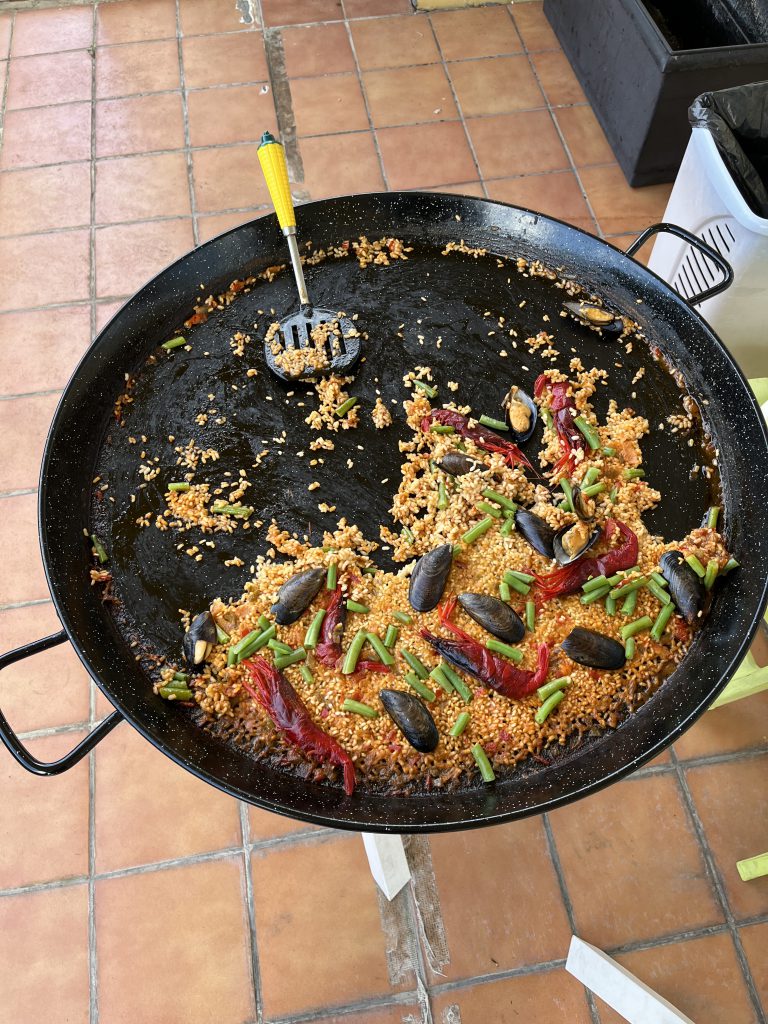
After the paella activity, we biked to the marina to catch the ferry to Santa Clara island. Upon arriving at the ticket booth, we discovered that all trips had been canceled because of strong winds and forecasted rain. Though at the time there were clear blue skies all around, I can understand the company’s decision. White caps could be seen all over the bay and massive waves were crashing onto the beaches.
The rain did not set in until much later in the day. Typically, Basque Country rainfall is very light and misty, a phenomenon known as txirimiri. Today’s rain was different. Heavy droplets fell from the skies, splattering on our heads and clothes. We were assured that the evening’s fireworks would never be canceled because of rain, but a few minutes after we claimed our spot to watch, a security guard informed us that the fireworks display had in fact been canceled. We later learned that was the first time in 30 years that San Sebastián had canceled the fireworks show. (As of the time I´m writing this, it has not stopped raining and the wind is brutal).
—
The past few days have certainly had their ups and downs (some of which have been omitted for simplicity), but learning to go with the flow is an important part of life. If your bus gets delayed because of traffic, there’s not much you can do except enjoy the ride. If the fireworks get canceled because of the weather, the best you can do is run inside a pintxo bar and not get soaked from the rain. If the Basque Country has taught me anything, it’s that it is important not be too hard on yourself, take a siesta, and eat gelato every day.
Stranded outside San Sebastian
Day 1: Hondarribia
We walked out of the bus and immediately we saw cars parked by the curb, gated houses, palm trees, locals, and after a little walk, an outdoor escalator, yes you heard that right, an outdoor escalator had peered to the left! It led us in like a portal to the real deal of what tourists come to see from all over the world.
I felt that there were layers to this place. Where our bus stopped was only the outskirts where you have the residential areas, but the outdoor escalators sucked us into the magnificent integration of tourist and residential life. Each apartment building was unlike the other and there were lots of contrasting and bold colors for the basque style homes, each marked by boutiques/stores on the ground floor. We kept walking and got onto a trolley that took us around this petite, but architecturally intricate city. We went up a mountain that had mansion-like homes with a rural aesthetic. In the center of the town, near the cathedral, there were medieval style homes, fortresses, and gates. I was interested in finding out why that area stood apart from the rest with its narrow, heavily cobbled streets and medieval structures. Upon doing some research, I found out that it is called the Old Quarter. It is characterized by fortresses and gates. Puerta de Santa María is the gate that leads into this old town.
On one side of the bridge, you have the rural areas and on the other, you have quite the contrary, medival areas.
There is a castle of Charles V located on the Plaza de Armas in the center of Hondarribia. Formerly a palace and castle, the French army destroyed part of the building in 1794. It is a fortress town as it’s located 20 kilometers east of San Sebastian, 20 kilometers west of Saint Jean de Luz in France, or 35 kilometers from Biarritz. The final sector of the town I observed would be the Basque homes in the marina district, being an important fishing harbor. The marina district was tied together by each balcony having been adorned with beautiful flowers.
Day 2: Stuck in Biarritz, France
We chose to go to Biarritz on Saturday, so we could spend the entire day there to really soak in its beauty. Biarritz is an elegant, French Basque city. We stepped out of the bus at the airport and took a local bus that would stop near the Maison Adam place. It is home to the world’s most famous Basque macaron.
A fun fact is this town came up with the Basque macaron, a well-guarded recipe that only three people alive know. It tastes like a buttery biscuit that just effortlessly melts in your mouth. I went looking for a typical French macaron and tried 3 different flavors, blueberry being my favorite! This town was characterized by white buildings with accents of lightly colored stone facades and wrought iron balconies.
We made our way to the rock of the Virgin Mary, named after the statue of Virgin Mary that is looking out into the sea. To get there, we climbed up stairs on a hill. Atop the hill, there was a nice view into the sea and then we climbed down another flight of stairs to get to the rock. Upon admiring its charm and taking pictures in front of the Virgin Mary and the tunnel, we rushed our way back for our 2:50 bus.
We arrived at 2:52 with no sight of our bus, so the question at hand was if bus left on time (or early) or it didn’t come at all. We sat there patiently for a half hour, trying to convince ourselves it was delayed. That half hour turned into an hour, at which point we knew it wasn’t going to come. We made our merry way back to the streets of France, getting to our unfinished business such as checking out the shops that we didn’t initially have time for. When we got back, I needed to use the restroom, but my finger got caught in the push to flush button, which quite literally peeled off layers of my skin and created a hole in my finger. Enough of the gory imagery. Oh this day only gets better. We went looking for a pharmacy and I asked for the French version of Neosporin but apparently it’s prescription based so I had to settle with these bamboo band-aids.
We went to the most dainty bookstore to ever exist.
The bookshelves were organized as such: English, religion, voyage, guides on the first floor and French literature, policies, history, science and humanities on the top floor. I found it interesting how the first floor had English books and the upper floor had French novels. The English bookshelf was placed strategically to attract tourists as when you walk in your eyes go straight to the English books up ahead. Eventually, we made it onto the second bus!
At around 9, we got to Parte Vieja for the Semana Grande. We came to the church in Parte Vieja and started dancing with people in yellow vests. We felt like we were part of the performance as I and a couple others from our session rushed through the crowd to get to the front. They were playing the drums and I was mimicking their actions. You could just see crowds of people in uniform motion swaying side to side with the beat of the music. I felt like I was part of this festival and this segment of the festival really made me fall in love with the culture and aura of San Sebastian even more.
We made our way to fair. That was the best fair food I’ve ever had. Like C’mon how can you top Nutella, Kinder, and oreo covered waffles. My favorite ride was the swing one. On the swing ride, I kept saying that I’m flying off my seat and Ashley thought I said there’s flies on my feet. There were times I thought I would slip out of my seat as I kept bouncing around in there because there was a lot of room. I was filled with energy and wanted to stay out more, but I had to sleep for we were going to Zugarramurdi the following day.
Day 3: Stranded in a Witch Town
The sounds of the leaves rustling outside was really setting the tone for a spooky day ahead. The person at the front desk didn’t know of any taxis that go to Zugarramurdi. He knew a train went to Irun, but from there, he wasn’t sure of a taxi that went to the secluded town of Zugarramurdi. Then, the other person at the front desk gave us vague instructions on how to get to Irun via train (at Lugaritz) and a taxi station next to a casino, which he said would be a 10 minute walking distance from the train station. At our stop in Irun, they had a Papperino gelato place as well as a Lacunza school by the casino. It was like home away from home (San Sebastian). As we were driving up the mountain to Zuggaramurdi, I could see medieval, ancient-looking houses made with grey bricks and brown window panes.
We went to the museum and the caves. We also got to dip our toes in the creek, which Professor Z said is believed to have originated from hell.
Then, we picked up the Basque Witch Curse. No taxi driver was willing to take us back to Irun because he said the area is restricted as that would require one to cross the border of France to get here. However, we made it to Zuggaramurdi by going around France. So, his logic was not valid.
We got the help of the locals who said a driver in a BMW would come at 8 pm to pick us up. Even though we had a language barrier, there were so many people who knew both Spanish and English, which was a sigh of relief. Those three ladies were so kind to talk to the taxi company because we couldn’t understand what they were saying when we requested them to send a taxi. They suggested major cities that we can walk to, from where we can catch a bus. However, the nearest hub would be in France and none of us brought our passports. They went an extra mile to help us out by asking the workers at Zugarramurdi if they knew of taxis. These experiences are one for the books and are part of the adventure. They make for a great story time! It brought us closer to the natives, who are so willing to help when they very well could’ve said sorry and went about their day. Instead, they made sure we had a way to get back to our home. It also teaches us that language barriers can be overcome as long as there is a willingness to help and be there for one another. If we get stranded again, the locals have our backs!
We finished our night by watching the fireworks show put on by the Ukrainian team. It is actually the first time Ukraine has participated in semana grande. Right after, shots were fired for the bull run.
I watched from afar because I thought the flames would burn, but I learned that those were cool flames and won’t actually burn your skin or clothes. I might run next time! I still can’t process how I only have a few more days left here in San Sebastian. It will be tough saying goodbye to the town I referred to as my home when we went on these day trips.
Insight into the cooking societies of el País Vasco
Without a doubt, Basque culture and food are inextricable, and today we were given the opportunity to get a rare insider’s look into the sociedades (cooking societies) that dot the Basque Country. At these cooking societies, one can prepare delicious meals, eat with friends and families, and enjoy the pleasures of life in the Basque country.
We visited a special type of sociedad – una “confradia”. Like a normal society, they cook and eat together, but they have a special focus on the preservation and continued survival of basque food and tradition. To join one of these societies, you have to already know the members inside, and they have to invite you – you can’t just join any society you want, so good luck getting in as a tourist!
When we first arrived, we were given a tour through the building. Set in an old military building, the stone walls and old wooden beams contribute to the warm ambience of the many, many dining areas in the sociedad.
Next, we saw their library, full of books in Spanish, French, and even Basque, with a gastronomic focus. It’s named after Alexandre Dumas – a prolific writer with a particular love of cooking and eating.
Then onto the kitchen! Though you might not expect it, given the old building and demure exterior, there was a fully modern, well-equipped kitchen, supported by a wide assortment of ingredients.
For out meal, we prepared a variety of dishes, starting with some typical pintxos.
Widely cited as the original pintxo, we made “gilda”. Though you might struggle to match the ingredient quality, this one’s easy to make at home:
-Start with a skewer of some sort. (In fact, pintxo – pronounced pin-cho – comes from the Spanish word pinchar, meaning to pierce or skewer.)
Onto it, add:
-Three pickled peppers
-An anchovy
-An olive
And that’s it! There you have the most classic pintxo.
There’s much more than that, though, as we also had:
-Jamón iberico over half a hard-boiled egg on bread.
-Chistorra – the equivalent of elevated “pigs in a blanket” – light puff pastry surrounding a delicious fresh chorizo.
-Stuffed peppers with a mix of tuna and mayonnaise.
Then, for our main course, we had fish cooked in olive oil with onions and roasted peppers. To preserve the flavor of the fish, the guiding chef cooked it just a bit. As he said, just half a centimeter of white in the meat – totally raw in the center.
For the vegetarians among us, there were two special dishes. First, a mushroom scramble, from fresh eggs, diced mushrooms, garlic, and olive oil! Second, boiled artichokes.
You’ll notice that for each of these dishes – the ingredient list is so short! Three for the gilda, four for the mushroom scramble, and still under ten even for our almond-crusted cake. Because the basque country has access to such excellent, high-quality, fresh ingredients, there’s no need to cake them in spices, or drown them in processed additives. The basques know that between just a few ingredients, you can make a truly harmonious dish – be it a heaping plate or just a couple bites in the form of a pintxo.
Finally, our dessert course. When we first arrived, we rolled out dough, made a lemon, vanilla, and cream filling, and then filled the pastry with it. Then, after painting it with eggwash, we put mountains of almonds and then put it in the oven. If you try to recreate it at home – be sure not to open the oven within the first half hour! You wouldn’t want the dough to fall.
I’m sure you won’t want to hear just my perspective, though, so here’s some reviews of the various dishes from my classmates:
“The gilda was a unique mix of flavors, and the pepper and anchovy come together to make a surprisingly delicious bite.”
“That tomato and onion salad hit different.”
About the tuna, one classmate said, “He managed to pull out an exquisite depth of flavor with only the freshest, simplest ingredients of olive oil and salt.”
“That stuffed pepper was absolutely DELICIOUS!”
Even the bread was given glowing reviews! Baked fresh that day, pulled out of a bag full of artisan loaves, it really was delicious. Of course, bread plays a pivotal role, serving as the canvas upon which other ingredients are layered, and they come together to make culinary works of art.
That said, not every review was so positive. One dissenter said about the cake:
“I didn’t like the desert. I don’t like almonds.”
Overall, the class was informative, the meal was great, and it was – as always – a pleasure to break bread and relax with my classmates.
If you ever get the opportunity, I recommend you try these dishes at home. Though the quality of ingredients will never match that of this cooking society in the heart of the Basque country, it is undoubtedly worth opening your mouth and mind to the food and culture of the Basque region. Enjoy!
Food Through the Eyes of the Basques
The epitome of the Basque culture has long revolved around food and dining . Groups of friends and families have long gathered around tables to break bread and enjoy life. Starting back in Viking times, Basques have used the seas and the mountains to provide food for their citizens in a way that is so much more than just nutritional. Eating is a social event, especially here in San Sebastián where the concept of pintxos has created an environment rich in community ties. As you take a walk down the streets of Parte Vieja, you will find nothing but one bar after another providing customers with a pintxo and drink experience they won’t forget. With amazingly fresh ingredients, the food is some of the best in the world with multiple Michelin-star restaurants in the city.
In her book Basque Country: A Culinary Journey Through a Food Lover’s Paradise, Marti Buckley perfectly encapsulates the history of the Basque culture along with some of the most traditional, delicious, and inspired dishes of the region. After taking a kayaking trip out to Santa Klara island and stopping for lunch in some pintxo bars ourselves, we got the opportunity to meet Marti and discuss the culture of food in San Sebastián.
As a student at LSU, Marti had the opportunity that has now presented itself to all of us here and participated in a six-month study abroad in the Basque Country. While in the city of Pamplona and living with three French girls, her eyes were opened to the life that many parts of the world enjoy where cooking is taken as a beautiful art form and people take pride in using fresh-from-the-earth ingredients to make delicious dishes worth the time and effort. As it goes for many others that find their way to this part of the world, the culture of food left a lasting impression on her that led to an inevitable move back followed by the writing and assembling of her cookbook which has earned awards by the Basques themselves.
As a country fighting to hold their independence through the reign and fall of empires, the Basque people have been known to be very wary of outsiders, spotted easily by their inability to speak the language. Luckily for us, Marti was able to use her love of food and aspirations to bring good light to the people and culture of the Basques to forge bonds with those who know first hand what being Basque is all about. Before this book, not much had been written about the history, culture, and recipes of the Basque people, at least not all int he same book. Through her ties with the community, Marti was able to create, as an American, a rare commodity that was kept authentically Basque.
Although once a tourist herself, Marti has now become a permanent member of the San Sebastián community and has experienced all of the trials and tribulations that come with living in a tourist town. As tourists ourselves, we have been participating in all of the activities a typical out-of-towner might. With a constant stream of outsiders coming in, the real estate market, as well as the traditions of the area have taken a hit.
While hiking to the top of Mount Urgull, kayaking to Santa Klara island, day trips to the vineyard, and pintxos in Parte Vieja or Gros are thrilling and breathtaking experiences for us, they are providing a close to unlivable environment for those whose roots stem from here. With the cost of rent leveling with and sometimes exceeding the average monthly income and residents being evicted so landlords can cater to the tourism industry, the traditional way of the Basques in San Sebastián has been compromised. In our discussion with Marti, she made it very clear how she hopes to help bring awareness to the Basque culture through her book.
Every society has its own way of expressing itself. For the Basque Country, this is food and language. Although it had only been 9 days that we have been here, I have already been submerged into this culture in ways that I never thought I would. From pintxo tastings in Parte Vieja to our Basque Language class with Stuart, my eyes have been opened to this whole new world that I never would have known existed. While acknowledging and adapting to the changing world around them, the Basque people have maintained the roots of their culture, which is something that very few societies have been able to do over the course of their lifespan. Our talk with Marti today only proved that further, and I am forever grateful to be able to experience life in San Sebastián.
Mount Urgull
The plan to hike mount Urgull seemed to have started a day early as a few other students and I find ourselves lost in a town outside San Sebastián. As we casually turn a 30 minute commute into a two and half hour trip, we jump from bus to bus and walk on the side of the highway with incredible views. However the outcome was definitely worth it, as for most of us who attended, it was our first horse race. We had students betting with no knowledge other than wanting to do it for fun and cheering on random riders as they hoped they would win. Fortunately we didn’t have such a hike back but we were saving that for the next day as we had Mount Urgull planned.
The day started off pretty regular as we attended class and had a free afternoon until we had to meet for 6 pm. As we arrived at the shared location we could already see the incredible views of the mountain with the statue of Jesus poking out at the top. The mountain is surrounded by one of San Sebastian’s beautiful beaches filled with people on this hot day and we were all excited to see this as a part of the view from the top.

The slight hike up this mountain consisted of a slight detour of going up stairs instead the steep uphill paved road. As many of us were huffing and puffing as well as losing some members we all made it to the top with the outstanding views of the forest and beaches along the way. When we reached the top, we came across the bottom of the statue and many canon replicas. I definitely had some questions as I had never heard any history about this part of the Basque Country and was curious to know more.
Professor Z was ready to answer as I asked the most basic question there is “so why is this here, what’s the story?” He began to explain that the statue was created in 50s, during the Franco dictatorship. Prior to this, the structure was a fortress. As San Sebastián just use to be the old part, this was built to protect against attacks from the sea and land. However, after the Spanish civil war, who ever had power was most likely supportive of the Franco regime — so religious iconography proliferated at this time, including Jesus atop Mount Urgull.
As we finished up hearing about some Basque history of the Franco dictatorship we made our way to the museum 6 minutes before closing. We did a quick look through of what they had in which it mostly consisted of the history of boats and voyages made. The Basques use to rely heavily on whaling in which the whale was referred to as the pig of the sea and every part of it was used. They were identified by their geysers in which those waiting at the towers would notice and send a signal for a boat to go out and harpoon the whale. The Basques began to travel further into the sea for whales as dehydrating cod had allowed them to do so because it could be preserved and stored on longer trips. The whole whaling process was very brutal as they bleed the whales out and dismembered them but sometimes the whales would win as they’d flick the passengers, or break their ropes. However, this was the price they were willing to pay because if they were successful in getting a whale it made them rich. This business led into being one of the early forms of investment and capitalism, as they needed help financing the ships in which they got investors.
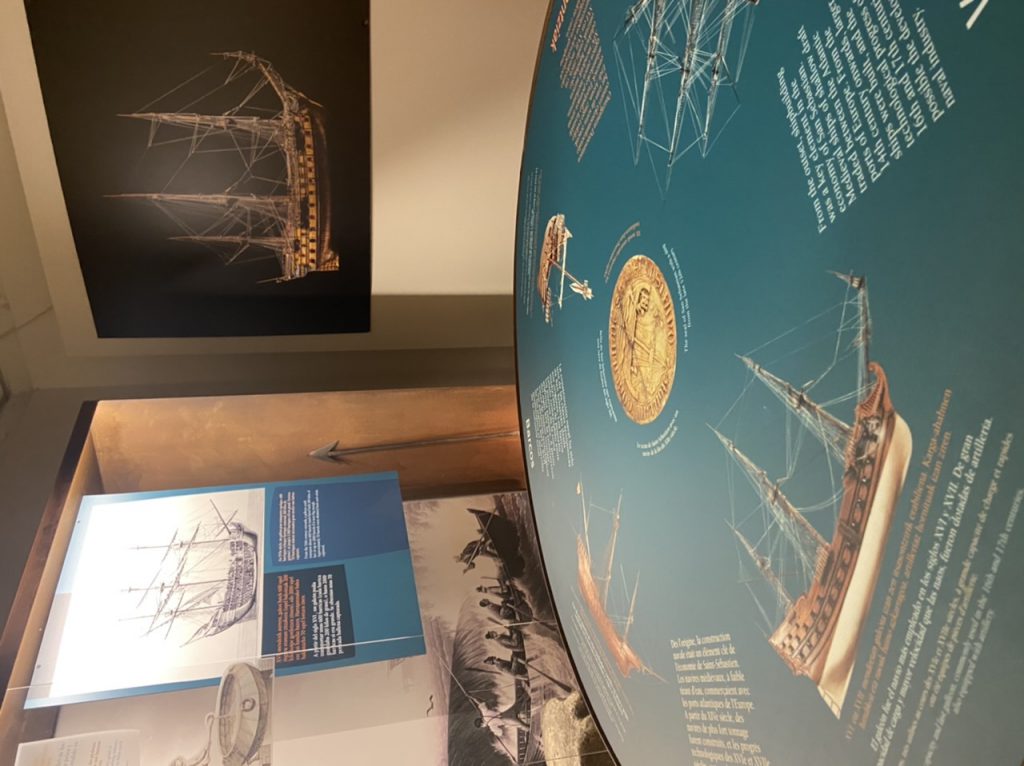
As we finished up the museum we made our way to a nice spot where the other students and I sat down to have a discussion about the book All That Followed by Gabriel Urza. We discussed how the book tied into Basque history as it was not a true story but was written on real events that took place in the Basque Country. The book was a good introduction to Basque culture and history that allows outsiders to get a taste of how much there is to know. One interesting historic fact I learned was that speaking Basque was prohibited many years back; meaning there was a huge loss of culture for the Basques. The Basques are very proud of their history, culture, and language because they fought so hard to keep it alive through everything that happened to them in the past.
Brushing upon Basque history by connecting it to the book was a great introduction of what’s to know about this beautiful city and it’s upbringing. There are many gorgeous sites to see and the view and stories from this hike are definitely not one to miss.
Picture Perfect Talai Berri Winery
Our first weekend in San Sebastián meant our group could sleep in a little later than usual. This was especially important because Professor Zabalbeascoa made it known that this would be the day to look our best if we wanted some great photo ops. After some necessary beauty sleep, we put on our best outfits, fixed our hair, and got on the bus that would take us to Zarautz, home of Talai Berri, the Txakoli Winery.
As someone who loves the countryside and breathtaking views, I was very excited for this trip. After seeing photos from past sessions, I had been counting down the days until I could see it myself. As the bus got closer to Zarautz, the scenery started to change and the beautiful hillsides became visible. Vast farms, beautiful quaint homes, and animals were scattered along the bright green fields.
We finally turned onto the driveway of Talai Berri and entered a small piece of history in the Basque Country. Bixente Eizaguirre, was the fourth generation and founded the winery in 1992, following a family tradition before him. We were greeted by one of his daughters. She and her sister make up the fifth generation to operate the vineyard.
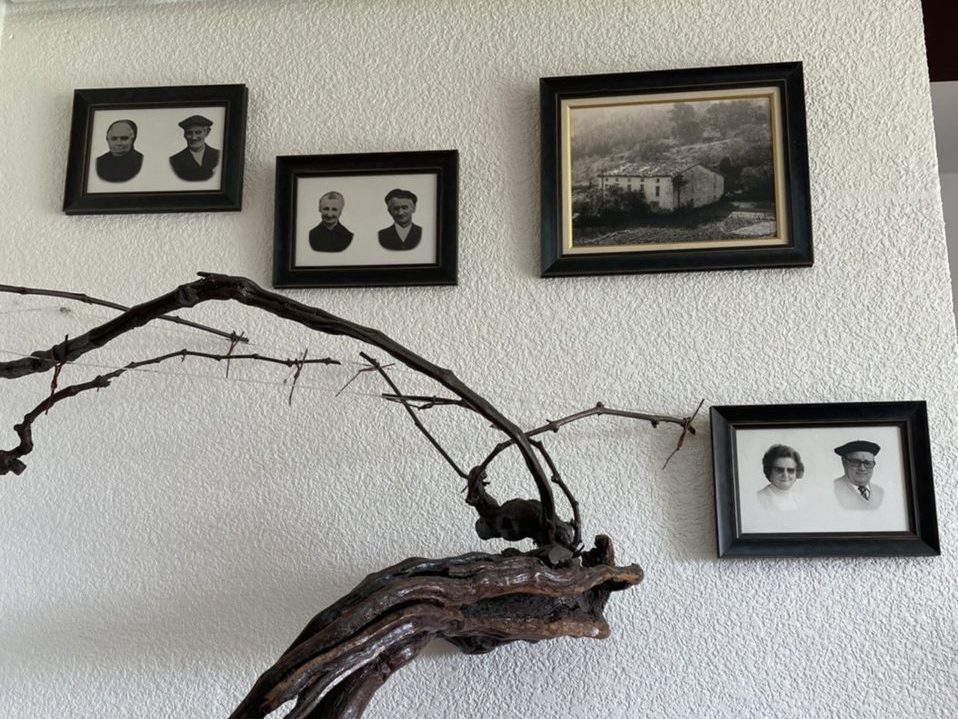
As we stepped into the building, the first thing I noticed was the bright light coming in from a circular window that made the rows of grapes visible on the hill. It was beautiful. The inside was nicely decorated and the natural wood made everything so picturesque. We stood in the entryway for a little while and we were told about some of the history behind this winery. I learned that the Txakoli they make has to follow specific guidelines from the Denomination of Origin (DO). This ensures that the wine is made from their area in the Basque Country. This winery, established in 1992, was the first winery exclusive for Txakoli making. The winery comprises 12 hectares of vineyards. Harvest season begins in late September/early October when all the grapes are collected in large wine crates. The process of making the wine then continues through November. Now you may be thinking, 12 hectares? They must have lots of people working to get it all done. I was surprised to learn that this is not the case! During the off season, only 4 people work at the vineyard including the two sisters. During harvest, they hire 14 part time employees just to help with the picking of the grapes and transferring. For the amount of work that goes into the wine making process, I couldn’t believe the small amount of employees they had. This information only emphasizes the dedication and pride that the family has in their wine. The daughter mentioned that although it is hard work, she loves doing it.
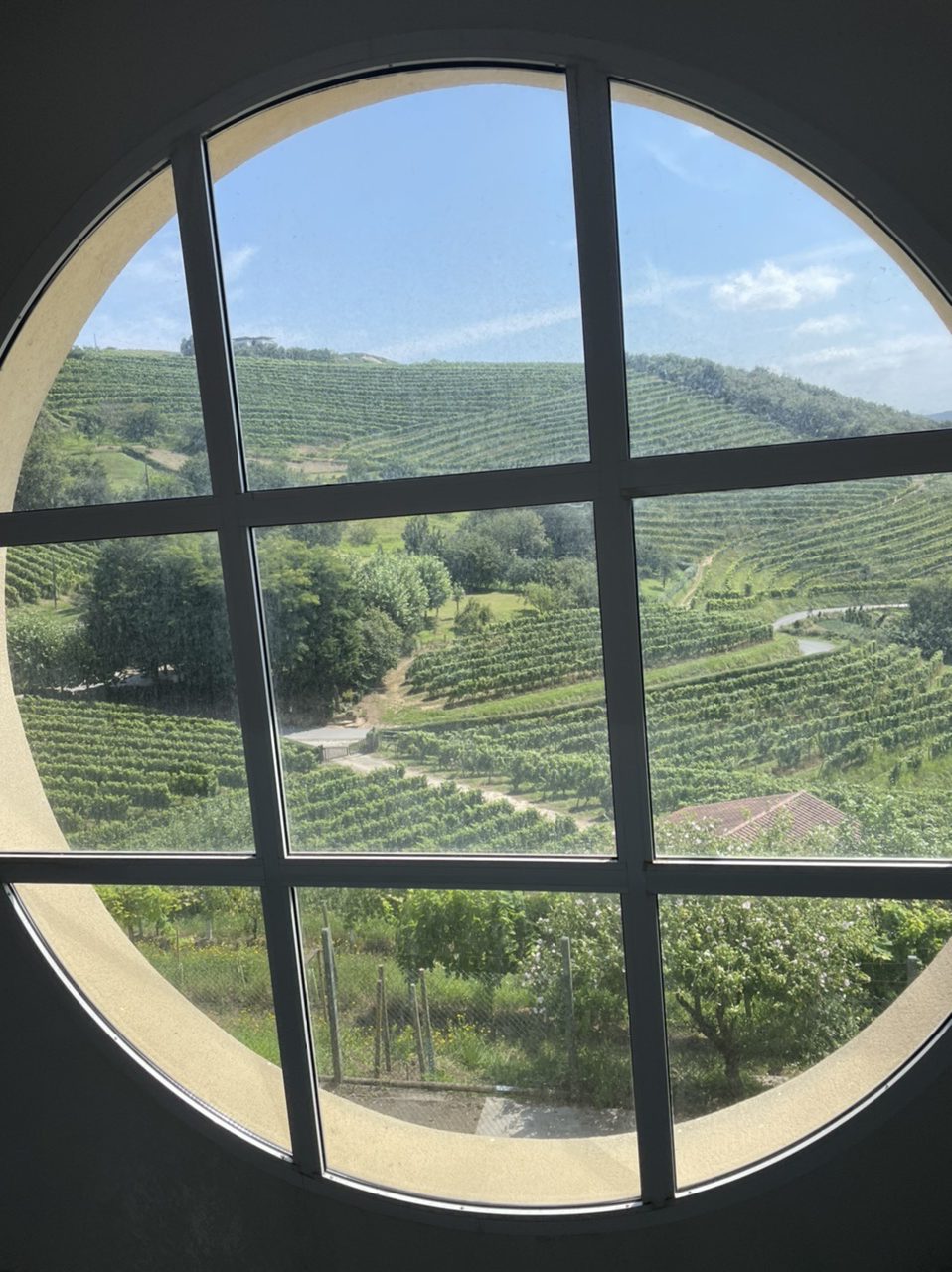
We were then directed downstairs to where the magic happens. Once the grapes are collected they are transferred back to the building via truck. The grapes are then poured down a long chute in a machine that washes the grape and removes unwanted parts. The grapes then go through an air pneumatic press and the juice is collected underneath. This is then used to make their famous Txakoli. The parts that were removed are sent and used to make Grappa. The press they use is about 30 years old! But because it only takes about 3 weeks to make all the wine, the press is able to withstand many years. Once the juice is collected it is moved into two large barrels where it sits at 10 degrees for 24 hours to be cleaned and filtered. This juice is then transferred into the rest of the barrels where it can ferment. The temperature is raised to 18 degrees and the yeast on the skin of the grape breaks down the sugar, releasing carbon dioxide. Fermentation takes about 15 days at first, but after that the rest of the wine only takes a few days. This is because the yeast from the first batch actually remains in the air and spreads to the other barrels speeding up the process. Kind of like how a COVID outbreak may work! During the last weeks of making the Txakoli, the cover on the top of the barrel is shut so some of the carbonation can remain in the wine. This is then sent to be cleaned one last time, bottled, and labeled with the DO.
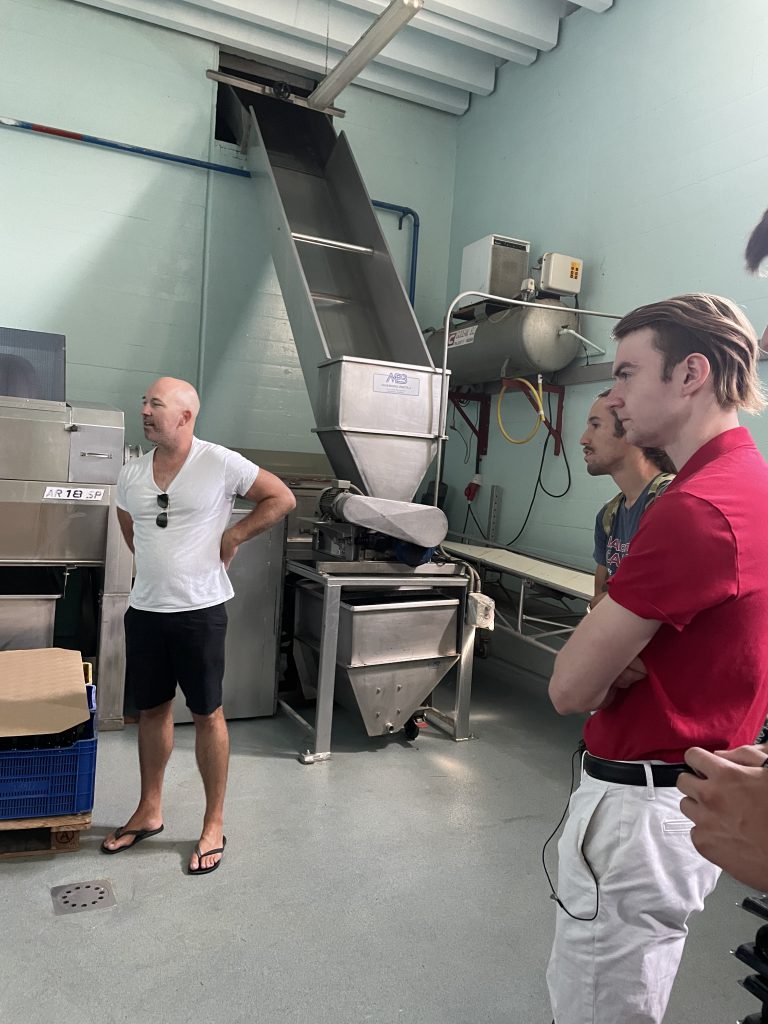
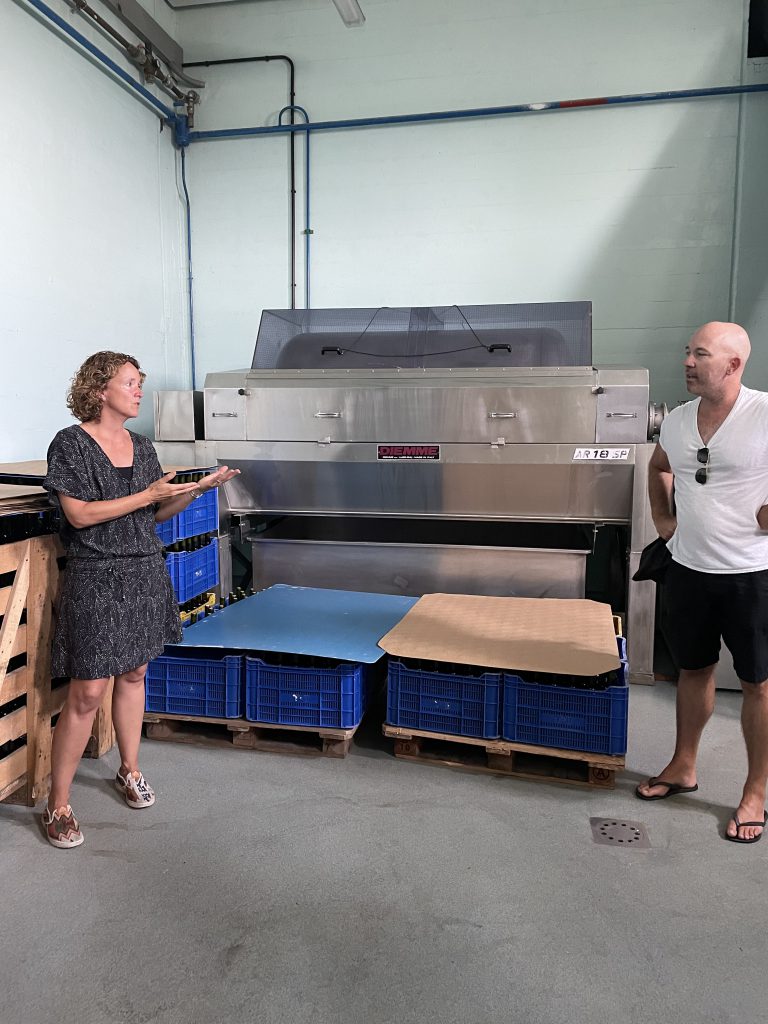

One of the most fascinating things I learned about this winery is their lack of pesticide use. The family strives to only use natural processes and methods when producing their wine. So instead of having pesticides and products to keep the vineyard safe, they use sheep! One obstacle that the family encounters is the humidity and fungus that can grow on the vines. Because sheep won’t eat unripe grapes, but they will eat leaves, they are the perfect solution! The sheep roam through the vineyard and eat the leaves, which allows for ventilation and stopping the fungus.
After our tour of the wine-making process, we were brought upstairs to the deck. I was aware this place was beautiful, but the pictures never do it justice. It was breathtaking to see the hills covered in vines, perfectly spaced in between with horses seen from afar. This created the perfect backdrop for us all to take some “insta-worthy” photos while we got to taste the Txakoli and eat some locally produced food!
Although we had a sneak peek of the Txakoli during our pintxo tasting, we got the real experience right at its origin. The wine was unlike anything I have had before. You could taste the slight sparkle of the wine due to the carbonation that I mentioned above. The wine paired so well with the bread and cheese making for a delicious afternoon treat. The wine definitely tastes better when you can understand all the work that goes into it… and of course with that unforgettable view!
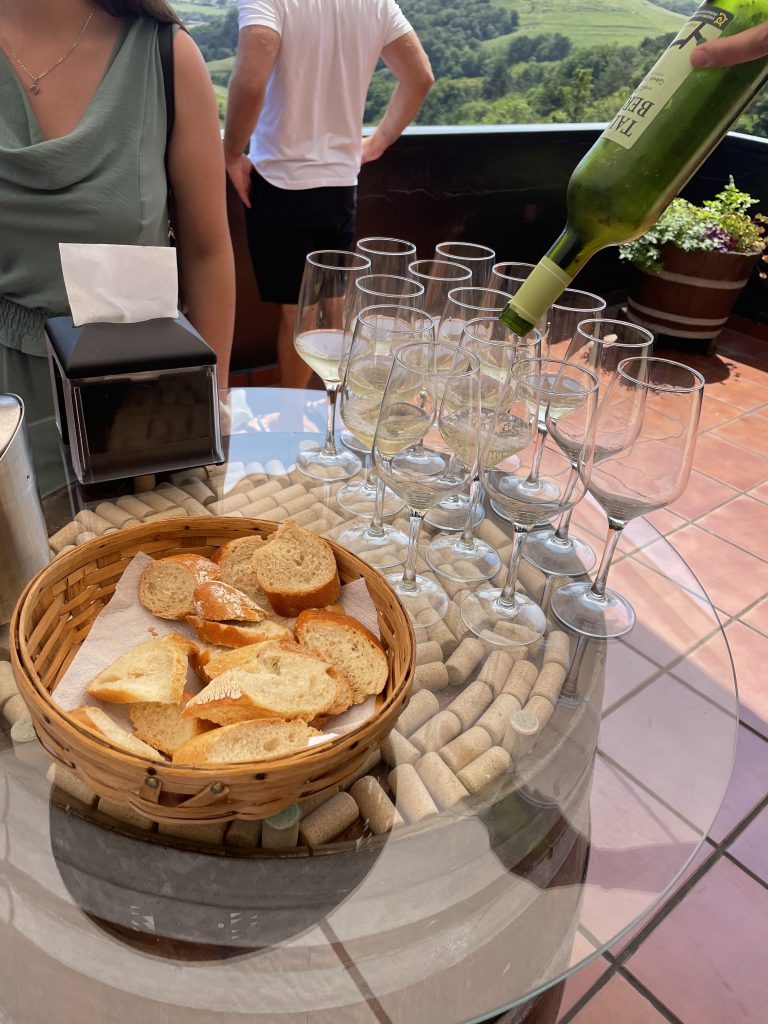
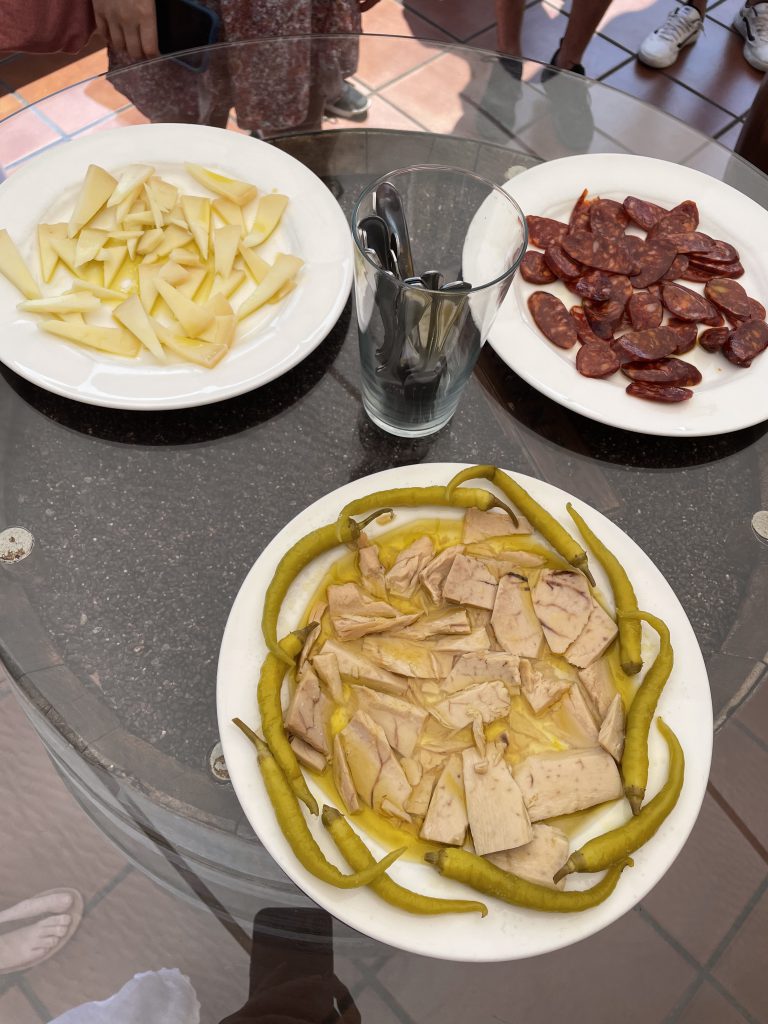


After we got back from the tour, a few of us took a nap on Ondaretta Beach, soaking in the sun. I don’t think I will ever get used to the view we have from the water, it’s incredible. This first week here has been a lot of firsts for me: first pintxo, first anchovy, first olive, first time learning the Basque language, and first wine tasting. I already have so much to be grateful for on this trip, but I think the opportunity to grow and try new things tops the list. I am so excited for the next two weeks and I know saying goodbye to this place will be hard.
What is a Language?
Kaixo! Zermoduz zaude?
If you are wondering what you just read, do not worry. I would not have known either, if not for the Basque language class that we engaged in on our fifth day in San Sebastian.
Our class was led by Stuart, a Scottish man who is greatly familiar with Basque culture as well as other languages. He quickly introduced us to many key Basque words and phrases, such as the greeting I wrote above, meaning “Hello! How are you?”
Although such a phrase is quite basic, the pronunciation required in the Basque language is anything but that. It involves many unusual phonemes, such as ”z” which, as Stuart described, sounds like hairspray, “tz” which requires a harsher “tsssss” sound, “ts” which makes a “tshhh” sound, and “tx” which is equal to “ch”.
Sounds confusing? Believe me, it is! However, the complexity of Basque does not end there. In addition to words and pronunciation, Stuart educated us on Basque history, and the mystery behind it.
Stuart explained to us that there are written records from the 1st Century AD of a people called the Vascones inhabiting two parts of the Basque region: Navarre and Aragon. Studies of their language and that of the modern-day Basque show an etymological correlation. However, there is no overall proof of ancestry between the Vascones and Basque. Despite this, the Basque people take great pride in their history and its enigmatic nature.
While we continued to learn more about the Basque language and history, what I learned the most from my time with Stuart can be encompassed by two themes: pride and connection.
The first theme, pride, has already been discussed. While writing about Basque culture, it would be remiss of me to not mention the amount of pride that the Basque people have not only for their history, but for their home in the present and future. The Basque Region possesses a large amount of self-governance, and has their own independent taxation for its inhabitants. This has led to a thriving healthcare system, beautiful infrastructure, and from what I’ve seen, a high standard of living. In terms of the future, the Basque people have one of the highest life expectancies in the world, which is estimated to increase.
However, the only action needed to witness the pride within the Basque Country is to visit it! I have only been here for five days, yet I notice this strong self-identity all around me. As I walk through the streets of Parte Vieja and taste a Pintxo full of local livestock and produce, I can smell and taste the pride. When I try my best (which is not worthy of any applause) to greet someone in Basque, the expression on their face emits gratitude for my awkward efforts. Basque pride is all around me: in the food, the people, the beautiful bridges I bike on, the marvelous beach I relax on, and much more.
The second theme I found is that of connection. Growing up in the United States, I was first introduced to another language (Spanish) in middle school. Since then, I have continued to study Spanish in the hope of one day reaching fluency. Although, in my experience, aspirations such as this are few and far between. Most people in my middle school and high school either did not take language classes seriously, or quit the class and language altogether as soon as they got the chance.
On the contrary, the majority of people I have met in San Sebastian, of all ages, tend to speak more than one language. I acknowledge the fact that I am in a tourist city, yet I cannot help but express my amazement towards the amount of people who possess the ability to converse with people from various backgrounds. Additionally, I feel gratitude to each and every person who makes the effort to speak to me in English: a sentiment that leads me to a final question that I believe San Sebastián has answered for me.
As I sat in the park practicing a completely new and foreign language to my mind, and listened to the complex etymological history of Basque, a question, perhaps odd, entered my mind: what is a language?
While the class went on, I noticed curious locals stopping as they walked by us. They listened as we spoke, and smiled once they heard us speaking their native tongue. This had a profound effect on me. It showed me that a language is much more than a conversation. A language is a hug, needed by someone who has just entered a foreign country and hears their native language for the first time. Language is a handshake, held together by two people trying their best to conquer a language barrier, and the mutual respect they share for their efforts. Language is a fire, lighting a spark in someone who just heard one for the first time, and is determined to learn it, day by day.
Most importantly, I believe that now more than ever, language is a connection. Not just between two people, but between differing backgrounds, experiences, and stories that every person possesses. While my time in San Sebastián has only begun, I have already felt my perspective and personal beliefs being challenged by each foreign experience. Through each person I meet from all corners of the globe, I have made impactful connections with not only them, but the sentiments, perspectives and stories that they choose to share with me. In a world full of the turbulence of injustice, violence and greed, the small effort that language requires: a simple greeting or phrase, has the power to create a connection capable of change and benevolence for our world.
Pintxos 2: Tastebud Boogaloo
It comes as a bit of a shock to me to be writing this, but we’ve now finished our fifth day in San Sebastián. It still almost feels like less than a day ago that I felt the bump of our plane finally touching down in Bilbao just a minute short of midnight. Today, after hearing all about it from our classmates the day before, the second half of our group got the chance to explore San Sebastián’s pintxo bars and culture. Today, rather than repeat yesterday’s circuit in la Parte Vieja, we moved over to the Gros part of town, where we hopped around between five different Pintxo bars.
Although yesterday’s article offers some explanation of what pintxos are, I’ll provide a bit more since there is some rather interesting history to it. While one could be forgiven for thinking pintxos have been an essential part of Basque culture for centuries based on their ubiquity, the tradition actually has its roots in more recent times. During the Great Depression, bite sized portions of larger dishes, served alongside a small glass of wine or other alcoholic beverage, became popular among bars and restaurants as a way to keep customers coming in. Smaller and less expensive portions were more economical and allowed people to still enjoy the experience of dining out when times were tough financially. Later, in the 1970s, a group of Basque chefs who had been trained in nearby France put their own spin on the Basque classic, bringing French culinary methods to more traditional Basque ingredients and laying the groundwork for the complex and forward-thinking pintxo recipes that are served today.
Our pintxo tour began at an establishment called Casa Senra. Decorated with traditional stone and wooden beam construction, and featuring a long wooden table and matching benches, sitting down really felt like going back in time. This was appropriate as Professor Zabalbeascoa gave us a brief lesson on the history of pintxos while we enjoyed a small glass of white wine alongside some very good fresh tomatoes before we ordered our pintxos. Here, I was drawn to the salted cod, a dish I know from my Italian family’s cooking as Bacala, similarly named Bacalau in Spanish. Trying the bacalau, I was not in the least disappointed. It was delicious, as were the few bites of venison and thin-sliced Iberico ham that I sampled from others’ dishes. The ham is supposedly the best in the world, made from pigs fed only on acorns and free to roam in rural Basque pastures. Personally, I think it is a good example of diminishing returns, because, although it was indeed very tasty ham, I’ve had some non-acorn-fed prosciutto that was also pretty good.
The bacalau, with ham croquettes and venison in the background:
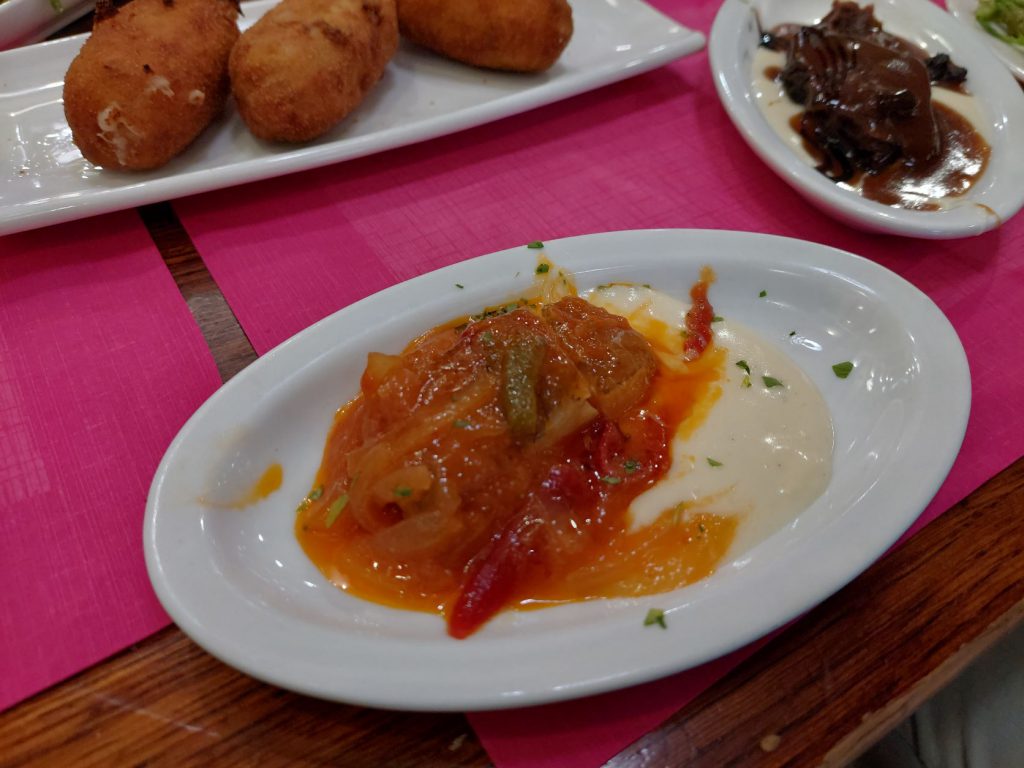
Moving on from Casa Senra, we passed several other restaurants and pintxo bars, each time getting the scoop from Professor Zabalbeasco about what was a good spot and when to go. Before long, we came to a small bar on a corner, with just a couple of tables out front and a counter full of pintxos inside. Here I sampled another fish pintxo, with some sort of yellow sauce on it. Unfortunately, despite the cute looks, neither the atmosphere nor the pintxo I tried justified spending much time there.
Next up, we found ourselves at a much more upscale establishment, and although I can’t recall the name, I do remember the proudly displayed Pintxos 99 Best award on the wall. The award is given to the 99 best Pintxos bar in San Sebastián (and there are plenty more than 99 to choose from) by a group of Michelin stared chefs from the area. Here, we each sampled a Russian salad pintxo. It featured what was essentially a potato salad, dressed up with a few more small bits of vegetables and some cream on top, served over a small baguette slice and supposedly with some tuna mixed in as well, though I couldn’t taste it. This was one of my favorite pintxos of the day, without a doubt. I do love a good potato salad, and although I’d probably rather forgo the fanciness of this pintxo in a larger serving size, it was fun to have something a little more adventurous for a few bites.
We came next to a place called Ramuntxo Berri. Here we tried a couple of pintxos, beginning with another one that I really liked, a piece of “carbon brie”, brie cheese covered in poppy seeds, so it looked like a block of coal, with a ring of sweet jam made from peppers around it. This was another peak on the pintxo tastiness meter. In addition to this, we also tried a few small chorizo sausages, which were good, but perhaps not quite enough for me to say you won’t find something similar closer to home. I also took the chance here to try a “gilda”. A gilda is supposedly the original pintxo, a combination of olive, pepper, and an anchovy, all atop a small slice of baguette and held together with a wooden skewer. Not being someone who particularly likes olives or anchovies, trying a gilda was really more for the historical experience than anything else. If you do like anchovies and olives, you’ll probably enjoy this pintxo more than I did.
The Carbon Brie at Ramunxto Berri
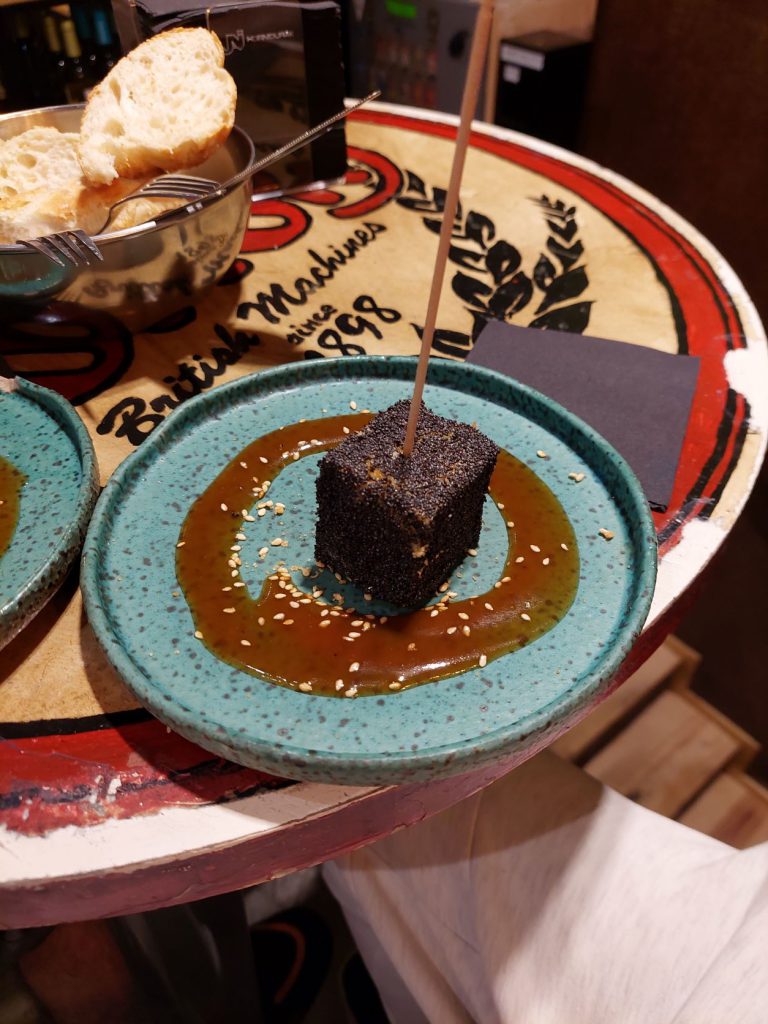
Before moving on to our dessert courses, I’d be remiss not to mention the last thing that I, and several others, enjoyed before leaving Ramuntxo Berri, which was perhaps one of the best bathroom experiences I’ve ever had in my life. Tucked away in the basement, a subtle blue glow graced the white porcelain facility from above, and the sink, sitting gently atop an elegant wooden counter, seemed poised to take flight like the graceful wings of a swan as the faucet poured into it what I can only describe as water so cool I could feel the crystals of alpine snow as they melted away on my hands.
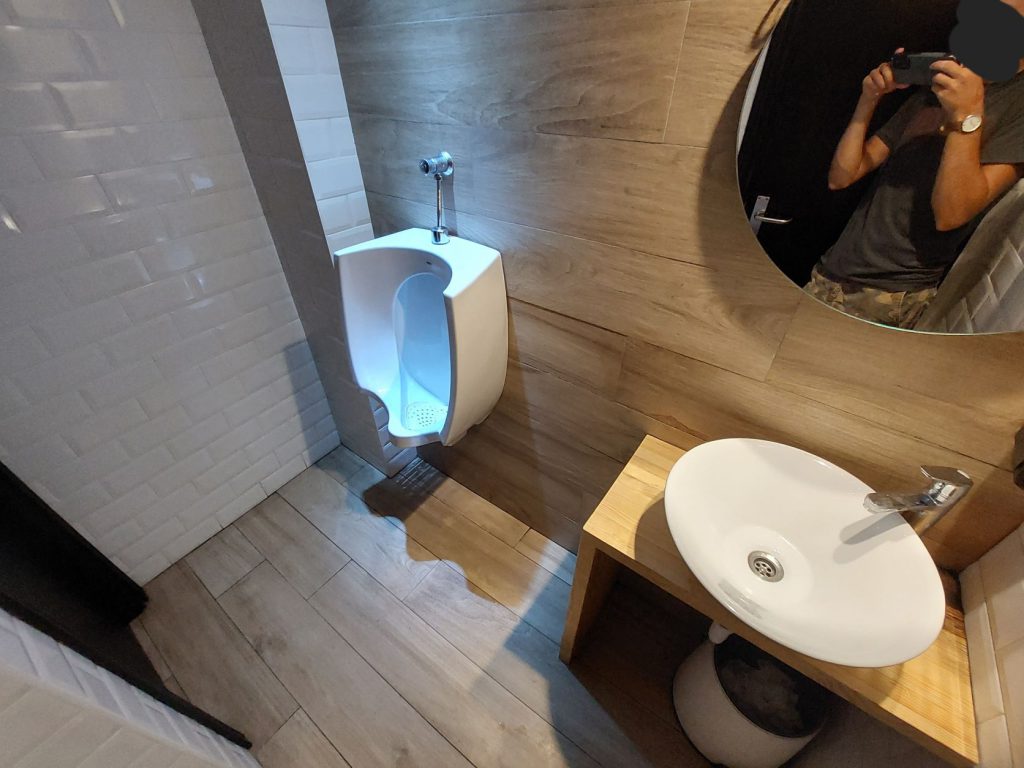
Finally at the end of our pintxo tour, our stomachs were full. Between the advice a former coach of mine once gave, to “never eat on an empty stomach”, and the well-known old adage, “there’s always room for dessert”, this seemed like the perfect time for some gelato. We wandered a few streets down and across a square to a shuttered garage door. As always, our professor had the inside scoop. Not ten minutes later, the door was lifted and business resumed after the 1-4pm siesta. It was a good thing we’d gotten there when we did; a line was beginning to form well into the plaza by the time we’d finished ordering. Just as on the American side of the Atlantic, the Spaniards love a frozen summer treat.
We capped off our culinary Tour de Gros with a bit of cheesecake and some reflection before heading back to the hotel. In the end, while our pintxos tour was not quite the unrelenting marathon of orgasmic and heavenly tastebud experiences that I’d come to expect based on Professor Zabalbeascoa’s descriptions, the highs far outweighed the lows, and I think I certainly have a new appreciation for the uniqueness and unabashed creativity of the culinary culture in San Sebastián. It is a special blend of old and new. It brings together the past and the present, using modern and adventurous styles and techniques with traditional and local ingredients to really push the envelop of what good food is. I should not forget to say, I am very glad to have experienced it, and I look forward to much, much more during the rest of our time in San Sebastián.
